hiding inside the black granite.
I said I wouldn’t,
dammit: No tears.
I’m stone. I’m flesh.
First 5 Lines “Facing It”, Yusef Komunyakaa, 2001
Komunyakaa wrote the poem at national Vietnam War Memorial. Its polished granite also reflects the white Washington Monument, a strange object of Masonic symbolism at the political heart of America. The Egyptian obelisk was reborn in the Americas and elsewhere due to its association with a powerful “boys” club. During the Mason’s strength between 1750 and WWI, the obelisk became a shape for graves, memorials and monuments to events. Today – not much use.
Student newspaper writer, Diana Greenwald, brought to my attention a temporary obelisk by Damian Ortega. Obelisco Transportable, a 20 ft tall black polish sculpture, has been rolling on a tiny spot of grass this summer in New York City. According to the Public Art Fund website, Ortega created “a mobile landmark” that one could potentially move anywhere to commemorate anything. Unfortunately, Greenwald reports that New Yorkers did not even notice the artwork and it sparked no ideas when pointed out by the young reporter.
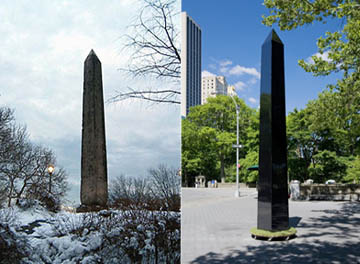
NYC’s Cleopatra’s Needle and Ortega
Beacon Hill Monument and Ortega
Ortega’s gallery work is a series of paradies of minimalism and conceptual sculpture. When examining his work, you get the feeling – “Look how easy it is to make a conceptual work. I can do Lewitt out of chairs”. The jokes require a knowledge not of only the past work, but the thinking and attitudes around both the creation of the art and the excessive 40 years of academic admiration. Ortega’s basic starting point of dialogue with this obsurity generates its failure as public art.
Unfolding / Flip Chair, 2005 and Módulo de construcción con tortillas, 1998
Ortega selects the obelisk as its has the same obsurity as 1960s artwork. As giantic versions exist as national symbols in the USA, Argentina,etc., the smaller ones are ignored. In the public imagination, the purity of the blank geometic shape only succeeds with size, for otherwise no meaning is attached to it. Scale is part of it. For example, I had no idea that the grave markers of Washington, Jefferson and Madison were small obelisks. And in my hundreds of walks in Central Park, I do not remember Cleopatra’s Needle, one of the 21 existing large Egyptian obelisks in the world, according to PBS’s Nova.
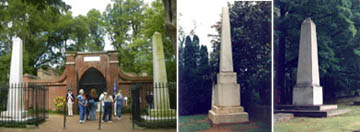
Masonic Graves: Washington, Madison and Jefferson
When the obelisk succeeds, they are placed at the center or the end. For example, see the plan of baroque Rome with its re-sited obelisks stolen by ancient Romans 1500 years before Pope Sixtus. Or the Washington Memorial at the intersection of the White House(President) and the Capitol (Representive Democracy). Or the Vicksburg, Mississippi, Civil War memorials (one of America’s great overlooked sculpture landscapes) at the locations of death. Ortega lets the sculpture float without its primary role of marking a spot. Obelisks are not about themselves. Ortega just laughs at the valuelessness of contemporary spots, rather than challenging us by selecting a spot.
To demonstrate Ortega’s fear of marking a place, I used the old trick of sending the “thing” on a world tour via photoshop.
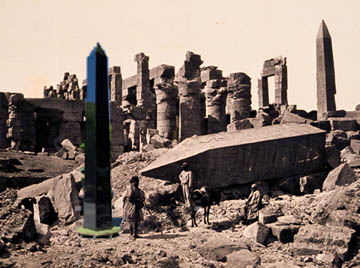
1863 in Karnac, Egypt and Ortega (Photo by Frith)
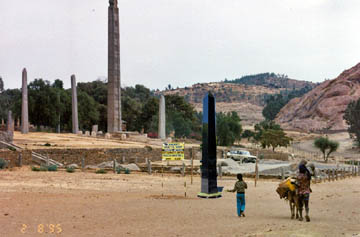
Axum, Ethiopia and Ortega
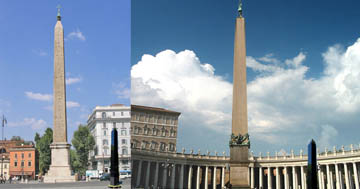
The Emperor, the Pope and Ortega
Ortega at Vicksburg, Mississippi
To demonstrate the sculpture’s lack of strength as a work of public art, I remind you of the infamous slab that appeared in a Seattle park on January 1, 2001. The unknown artist placed the slab without disturbing the earth so it had the appearance of dropping out the sky. The surprise arrival was brilliantly upstaged by the artist when he or she removed the slab one day later. The work’s had perfect symetry with Stanley Kubrick’s movie and drove the public’s imagination to that place of mystery at the start of the universe
Kubrick and Seattle One Day Monument, Jan 1, 2001
Digg it…Del.icio.us …Technorati…Stumble Upon..Reddit

From Maxwell at lightinghistory.blogspot
I think this argument only works if you address the work with the narrow values you’ve ascribed to it. Aside from commenting on the physical portability of monuments (i.e. commentary on the adjacent Cleopatra’s Needle), the obelisk also points to the commutability of conceptual meaning in monuments. For example, those Vicksburg markers you describe are actually not physically marking anything. They (and most Civil War battlefield monuments) are not actually arranged accurately to the battles they commemorate, and have therefore conceptually moved the locations of significant conflicts and death in order to acheive the dramatic picturesque qualities you seem to admire them for. I think that in addressing the conceptual mobility of monuments by way of a physical manifestation, Ortega’s work is rather successful.
Weiss Response
I admit to appreciating the pictureque qualities, but also the repetition at Vicksburg creates a sense of loss and pride of SO MANY. A peaceful image of death where all was violent.
I am narrow as I attempt to find the conceptual framework for public art and indentify its edges. Ortega movement is not very successful because he refuses in his work to admit the general public. The work is artworld focused with the appearance of publicness. An even in the artworld the poetry is quick and easy.